中东和非洲地板市场预计将从2024年的447.8亿美元增长到2031年的680.6亿美元;预计2025年至2031年期间的复合年增长率将达到6.4%。对可持续建筑实践的日益重视预计将成为市场的一个突出趋势。
中东和非洲地板市场分析
地板等建筑材料广泛应用于住宅和商业建筑。地板产品广泛应用于住宅、商业、机构和工业等各个领域。地板由不同的原材料制成,例如木纤维、橡胶、陶瓷、乙烯基背衬、乙烯基芯层、水泥、水、沙子、砾石、花岗岩、大理石、天然和人造纤维以及树脂。该地区建筑活动的增加归因于政府对基础设施建设的重视。住宅建筑活动的增加推动了对LVT地板、强化地板、木地板和地毯等地板材料的需求。
中东和非洲地板市场概况
由于中东和非洲地区基础设施项目激增、工业化进程加快以及可持续建筑活动不断涌现,地砖等建筑材料的需求也随之增长,从而推动了市场的增长。现代瓷砖在该地区越来越受欢迎,兼具美观与实用性。瓷砖被认为是一种经济实惠且用途广泛的天然石材替代品,能够以极高的精准度复制花岗岩、木材或大理石的外观。此外,随着人们环保意识的增强,使用可持续竹地板或再生木地板的趋势也日益兴起。
由于旅游业蓬勃发展和移民人口不断增加,该地区的商业建筑数量激增。不断增长的城市人口导致城市和半城市地区对私人住宅的需求激增,促使各国政府加大对建筑行业的投资。该地区还有多个正在进行和即将进行的住宅建设项目。例如,Walters on Cornerstone 计划于2025年12月在海恩斯波特开工建造一栋73层高的全新高档住宅楼。此类项目推动了该地区对各种地板产品的需求。此外,该地区建筑活动的增多以及政府通过“阿布扎比2030经济愿景”和“沙特2030愿景”等举措增加对基础设施建设的支出,预计也将对该地区地板需求产生积极影响。
您可以免费定制任何报告,包括本报告的部分内容、国家级分析、Excel 数据包,以及为初创企业和大学提供优惠和折扣
中东和非洲地板市场:战略洞察
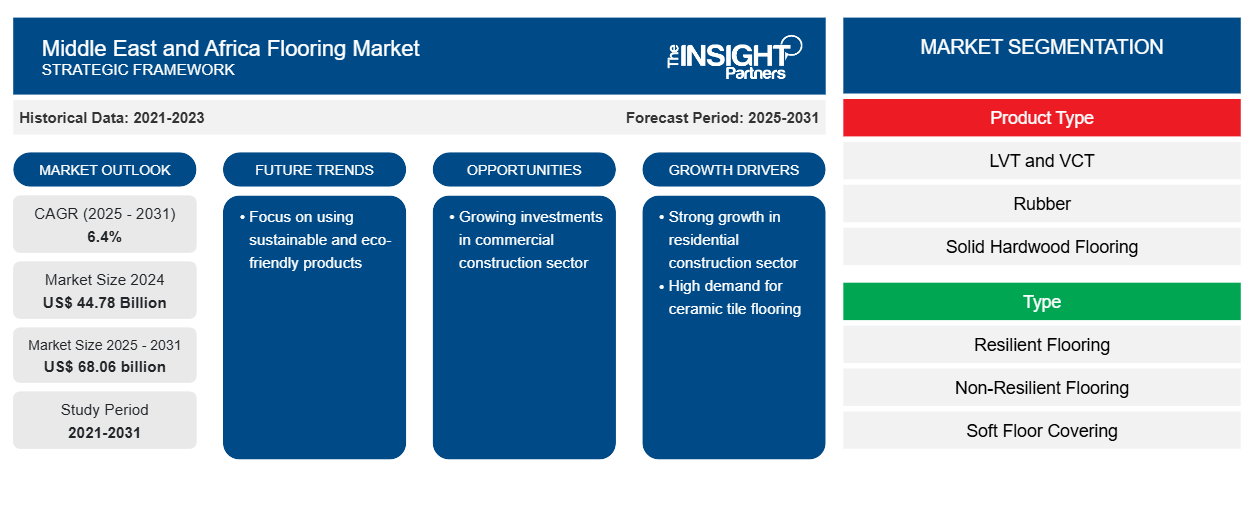
-
获取此报告的顶级关键市场趋势。此免费样品将包括数据分析,从市场趋势到估计和预测。
中东和非洲地板市场的驱动因素和机遇
商业建筑领域投资不断增长
中东地区正在大力发展以大众酒店开发为中心的项目。迪拜多年来一直在投资旅游基础设施。2020年世博会的成功举办为这一努力做出了巨大贡献,目前该地区正在建设大量的酒店项目,计划新增6.5万间客房。该地区致力于吸引游客,因此需要酒店基础设施来接待游客。因此,各国正在加大对酒店项目的投资,包括建设和开发酒店、度假村和其他酒店基础设施,以满足这一需求。德拉伊耶门、红海项目和奇迪亚等大型项目占据了沙特酒店建设项目的最大份额。德拉伊耶门计划到2030年建成38家酒店,共计5000间客房。因此,商业建筑领域不断增长的投资预计将为中东和非洲地板市场提供更多利润丰厚的机会。
住宅建筑行业强劲增长
在中东和非洲,住宅建筑活动激增,推动了对建筑和建筑材料的需求。由于移民人口的增加,该地区的住宅建筑建设激增。城市人口的增加促进了半城市和城市私人住宅建筑的建设,促使各国政府投资建筑业。阿联酋的建筑业正经历强劲增长,这得益于房地产开发的持续繁荣。在人口增长和外国投资增加的推动下,阿联酋的住宅市场蓬勃发展。根据英国皇家特许测量师学会 (RICS) 全球建筑监测报告,阿联酋的建筑活动增长了 54%,建筑项目呈正增长。RICS 报告还强调,阿联酋建筑业的增长遍及私营和公共部门,其中私人住宅项目增长率高达 58%。
此外,沙特阿拉伯拥有全球最大的建筑市场之一。该国的住宅建筑行业主导着其建筑业。该发展计划的目标是到 2025 年底建成 30 万套住宅单元,目前在建 15 万套。沙特阿拉伯的住宅建筑市场由多个令人印象深刻的大型项目引领,例如 ROSHN、NEOM 的 Norlana Development、Jeddah Central、The LINE 和 Masar。吉达的开发项目占地 570 万平方米,将为该市新增 17,000 套住房和 2,700 间酒店客房。第一阶段预计将于 2027 年完工,届时吉达的中心区将变成世界一流的住宅区。Masar 毗邻麦加大清真寺,占地 120 万平方米,旨在重新定义沙特最神圣城市的城市生活。沙特阿拉伯全国各地的大型项目正在为城市规划树立新的标杆,使该国能够从传统的住房开发模式转型为综合社区建设。因此,中东和非洲住宅建筑行业的强劲增长正在推动地板产品的需求。
中东和非洲地板市场报告细分分析
有助于得出中东和非洲地板市场分析的关键部分是产品类型、类型和应用。
- 根据产品类型,市场细分为LVT和VCT地板、橡胶地板、实木地板、瓷砖、混凝土、花岗岩瓷砖、水磨石、石灰石瓷砖、大理石瓷砖、地毯和地垫、强化地板等。LVT和VCT地板预计在预测期内将实现最高的复合年增长率。
- 根据类型,市场细分为弹性地板、非弹性地板和软质地板。2024年,非弹性地板在中东和非洲地板市场占据最大份额。
- 根据应用领域,中东和非洲地板市场可分为住宅、商业、机构和工业领域。预计住宅领域将继续在应用领域占据主导地位,并在预测期内拥有最高的复合年增长率。
中东和非洲地板市场份额(按国家)分析
阿联酋占据中东和非洲地板市场的最大份额。政府对大型项目(包括商业和住宅建设项目)的投资激增,为阿联酋的建筑业创造了机遇。此外,随着城市人口的增长,政府正致力于支持阿联酋私人住宅的建设。阿联酋的基础设施发展议程推动了建筑业的发展,根据国际贸易协会2022年发布的报告,建筑业的产值将增长3.7%至4.7%。因此,预计阿联酋建筑业的增长将在预测期内推动地板需求的增长。
预计沙特阿拉伯市场将在预测期内创下最高复合年增长率。据沙特承包商管理局称,截至2023年5月,沙特阿拉伯建筑业产值达680亿美元,占该国GDP的6%。沙特阿拉伯正在经历转型,政府的目标是减少对石油和天然气收入的依赖,并利用旅游业和公共服务业。长170公里、宽200米的线性城市“新线”(Neom)于2021年开始建设。2023年,沙特承包商管理局组织了未来项目论坛,展示了3000个项目,估值2700亿美元,从而为该国的多家地板制造商创造了投资机会。
中东和非洲地板市场区域洞察
Insight Partners 的分析师已详尽阐述了预测期内影响中东和非洲地板市场的区域趋势和因素。本节还讨论了中东和非洲地板市场在北美、欧洲、亚太地区、中东和非洲以及南美和中美的细分市场和地理分布。
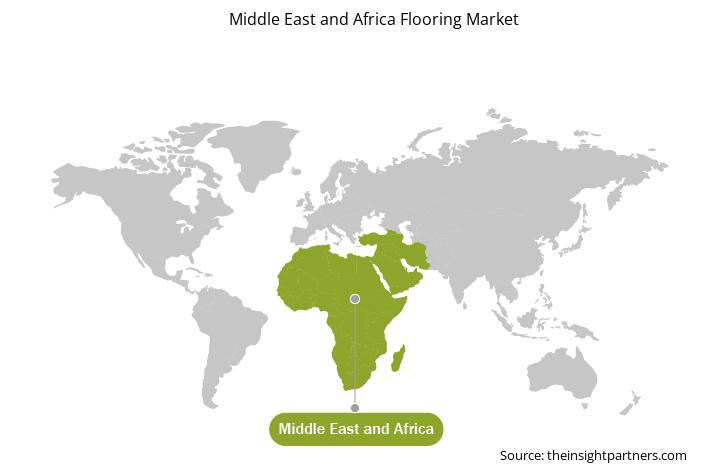
- 获取中东和非洲地板市场的区域具体数据
中东和非洲地板市场报告范围
| 报告属性 | 细节 |
|---|---|
| 2024年的市场规模 | 447.8亿美元 |
| 2031年的市场规模 | 680.6亿美元 |
| 全球复合年增长率(2025-2031) | 6.4% |
| 史料 | 2021-2023 |
| 预测期 | 2025-2031 |
| 涵盖的领域 |
按产品类型
|
| 覆盖地区和国家 |
中东和非洲
|
| 市场领导者和主要公司简介 |
|
中东和非洲地板市场参与者密度:了解其对商业动态的影响
中东和非洲地板市场正在快速增长,这得益于终端用户需求的不断增长,而这些需求的驱动因素包括消费者偏好的不断变化、技术进步以及对产品优势的认知度不断提高。随着需求的增长,企业正在扩展产品线,不断创新以满足消费者需求,并抓住新兴趋势,从而进一步推动市场增长。
市场参与者密度是指特定市场或行业内企业或公司的分布情况。它表明特定市场空间内竞争对手(市场参与者)的数量相对于其规模或总市值而言。
在中东和非洲地板市场运营的主要公司有:
- 美利肯公司
- 杰福乐公司
- 得嘉
- 福尔波控股公司
- 萧氏工业集团
- AHF有限责任公司
免责声明:以上列出的公司没有按照任何特定顺序排列。
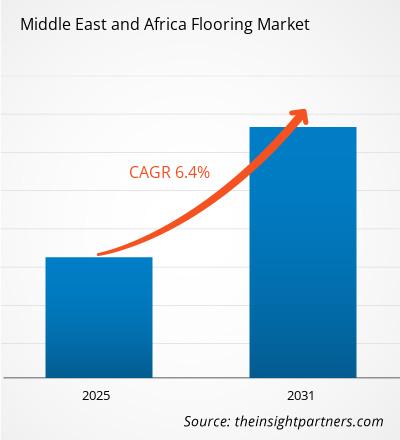
- 了解中东和非洲地板市场主要参与者概况
中东和非洲地板市场新闻及最新发展
通过收集初步和二次研究的定性和定量数据来评估中东和非洲地板市场,其中包括重要的公司出版物、协会数据和数据库。
中东和非洲地板市场报告覆盖范围和交付成果
《中东和非洲地板市场份额和预测(2021-2031)》报告对以下领域进行了详细的市场分析:
- 中东和非洲地板市场趋势以及涵盖范围内所有主要细分市场的预测
- 中东和非洲地板市场趋势,以及市场动态,如驱动因素、限制因素和关键机遇
- 详细的波特五力模型和 SWOT 分析
- 中东和非洲地板市场分析涵盖主要市场趋势、国家框架、主要参与者、法规和最新市场发展。
- 行业格局和竞争分析,涵盖市场集中度、热图分析、知名参与者以及中东和非洲地板市场的最新发展
- 详细的公司简介
- 历史分析(2 年)、基准年、预测(7 年)及复合年增长率
- PEST和SWOT分析
- 市场规模、价值/数量 - 全球、区域、国家
- 行业和竞争格局
- Excel 数据集
近期报告
客户评价
购买理由
- 明智的决策
- 了解市场动态
- 竞争分析
- 客户洞察
- 市场预测
- 风险规避
- 战略规划
- 投资论证
- 识别新兴市场
- 优化营销策略
- 提升运营效率
- 顺应监管趋势












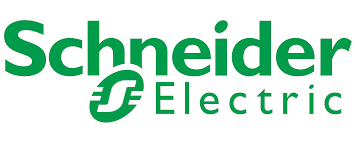


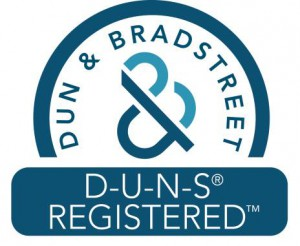
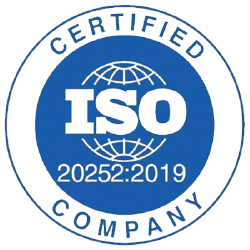





 获取免费样品 - 中东和非洲地板市场
获取免费样品 - 中东和非洲地板市场